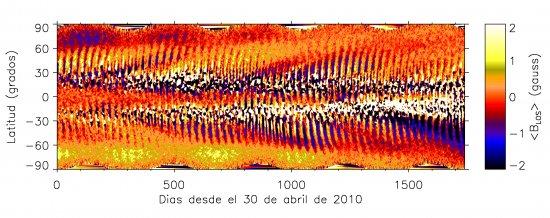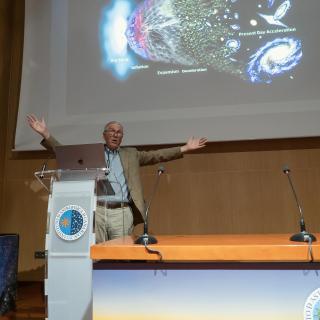The magnetic and dynamical (heliographic) axes of the Sun may not be aligned, according to research by scientists of the Institute of Astrophysics of the Canaries (IAC): This result should give rise to substantial changes in the models for the generation and evolution of the solar magnetic field, which until now have used the assumption that these axes are aligned. The article, whose authors are Adur Pastor Yabar, María Jesús Martínez González, and Manuel Collados, was published in the most recent edition of the specialized journal Monthly Notices of the Royal Astronomical Society. This “letter” produced a special mention in the digital version of American journal Physics Today, which will be published in print in October.
To obtain these results the researchers have used data from the Solar Dynamics Observatory satellite (SDO), specifically magnetograms (maps of the projected value of the magnetic field along the line of sight). Averaging these over intervals of 1o of latitude for the whole range of longitudes for every day of the mission they have been able to study the time evolution of the global magnetic field for the (approximately) 1700 days of observation. By doing this they discovered a weak oscillating signal which, using Fourier analysis (a tool which is used to study periodic signals) they found to be associated with the differential rotation of the Sun (the Sun rotates more rapidly at its equator than at its poles). They could rule out the possibility that this was due to random appearances of active regions on the solar surface, because even when the effects of these were eliminated, the signal persisted.
“We will have to carry out further studies which will help us to better understand the Sun and its global magnetism, for which missions such as SDO or Solar Orbiter are essential” explains the first author of the article Adur Pastor Yabar, who is at present working on his Ph.D. thesis at the IAC on the study of the magnetic fields at the solar poles. “Up to now, because there had been no detection to contradict this, the magnetic axis and the rotational axis of the sun were thought to be aligned, even though in other stars the opposite is observed. As a result of this work the Sun need no longer be considered a peculiar star” this young researcher told us.
The degree of misalignment between the two axes has yet to be determined, and so have the consequences for the solar magnetic cycle (the period of 11 years in which the Sun varies its activity as shown, notably, by the number of sunspots on its surface) and for related areas such as Sun-Earth interaction.
Reference: Mon. Not. R. Astron. Soc.453, L69, 2015
Contacts:
Adur Pastor Yabar: apastor [at] iac.es ( apastor[at]iac[dot]es) (+34 922 605 200; Ext. 5533)
María Jesús Martínez González: marian [at] iac.es ( marian[at]iac[dot]es) (+34 922 605 200; Ext. 5238)
Manuel Collados: mcv [at] iac.es ( mcv[at]iac[dot]es) (+34 922 605 200; Ext. 5464)



